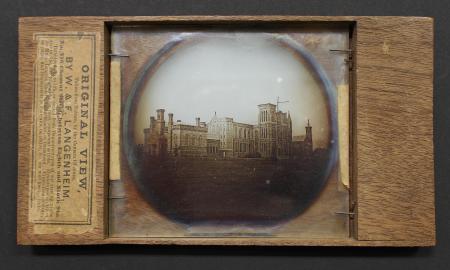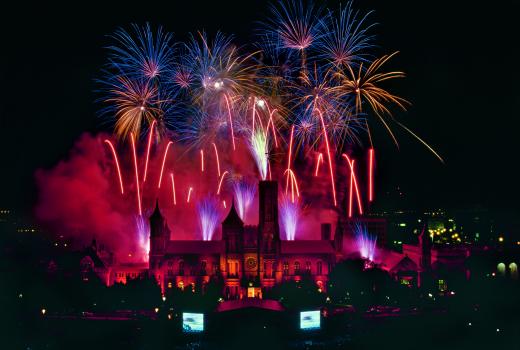The Smithsonian Institution Building, or the “Castle,” is the most iconic of all the Smithsonian’s 769 facilities, which include its nineteen museums, nine research centers, National Zoo, and all of its other establishments. The Castle was the first building constructed specifically for the Smithsonian after it was founded in 1846. On March 19, 1847, a contract was signed with James Dixon and Gilbert Cameron to construct the building. The Board of Regents wished to create a multipurpose structure that would include a library, museum, gallery of art, laboratories, and a lecture hall. They wanted an imposing design that would inspire those who entered the building to pursue James Smithson’s mission for “the increase and diffusion of knowledge.” The board chose a Romanesque style design by architect James Renwick that stood in stark contrast to all the classical white marble edifices in the city. The Castle is of red sandstone and it is completely asymmetrical on all sides, with nine unique towers. Today it is the Smithsonian’s administrative center and houses the Visitor Information Center where visitors can start exploring the world’s largest museum and research complex.

The cornerstone was laid on May 1, 1847 by the Most Worship Grand Master of the Freemasons, with appropriate pomp and circumstance, and the east part of the building exterior was completed by December 31. The structure was built in sections—first the east, then the west, finishing with the central portion. Construction moved slowly, however, and the Dixon and Cameron partnership quickly fell apart. Dixon had done the preliminary work on the site, but by July 23, 1847, he asked the Board of Regents to release him from the contract and they did so.
The stone façade of the building came from a quarry in Seneca, Maryland. After quarrying and shaping the red sandstone blocks, they were transported to the site via the C&O and Washington Canals. This proved a major choke point. The canal had numerous problems during these years. It was always closed from December to March, but also sometimes shut down for as long as four months for repairs after floods and other crises. Cameron’s workers prepared sandstone blocks while the canal was closed, and then he shipped as much rock as possible when it reopened. At one point, he had almost 15,000 feet of stone ready to send when the canal reopened. Nevertheless, Cameron pushed forward and by 1855 the building was completed. Secretary Joseph Henry’s family lived in the east wing and the remainder of the building housed laboratories, workrooms, a library, gallery and lecture hall.

The extraordinary photograph, above, taken during the Castle’s construction, is the earliest known view of the building. The two wings of the building were completed and occupied, but the central section of the building, while under roof, was still an empty shell and would remain unoccupied until early 1855. Two small towers were completed in this scene, but the seven others were still under construction. A crane rose from within the partially completed North Tower that would eventually reach 140 feet above the Mall. The Carriage Porch at the front of the building would not be completed until autumn 1851. In front of and to the right of the building was a workman's shed, possibly for use by the stonemasons. Small bushes and saplings in the foreground, planted by the Smithsonian, presaged the landscaping plan designed by Andrew Jackson Downing (1815-1852) for the area he named the "Smithsonian Pleasure Grounds."

We think of the Smithsonian Castle as sitting on prime real estate, but that was not so in 1850. The stinking, fetid Washington Canal cut the Castle off from downtown Washington. The Tidal Basin had not yet been filled in, so the Potomac River, a breeding ground for diseases like typhoid and cholera, flowed quite nearby. To go downtown, one had to travel down the Mall to the railroad yards, on 4th Street, toward the Capitol. Next to the railroad yards was the red light district that serviced the nearby Congress. Eventually more bridges were built and later the canal was filled in.

Not everyone admired the red structure. Reformer Dorothea Dix called it a "monstrous pile of misshapen towers, arches, columns . . ." But most of the staff and public grew fond of the unique character of the structure and today it is the icon of this most unique Institution.
Related Resources
- History of the Smithsonian Institution Building, The Castle, Smithsonian Institution Archives
- "Smokin' Smithsonian," by Aly DesRochers, The Bigger Picture, Smithsonian Institution Archives
- Stereoviews of the Smithsonian Institution Building, Smithsonian Castle Collection
- When the Castle Stood Alone, Smithsonian Mobile, Smithsonian Institution
Produced by the Smithsonian Institution Archives. For copyright questions, please see the Terms of Use.

Leave a Comment